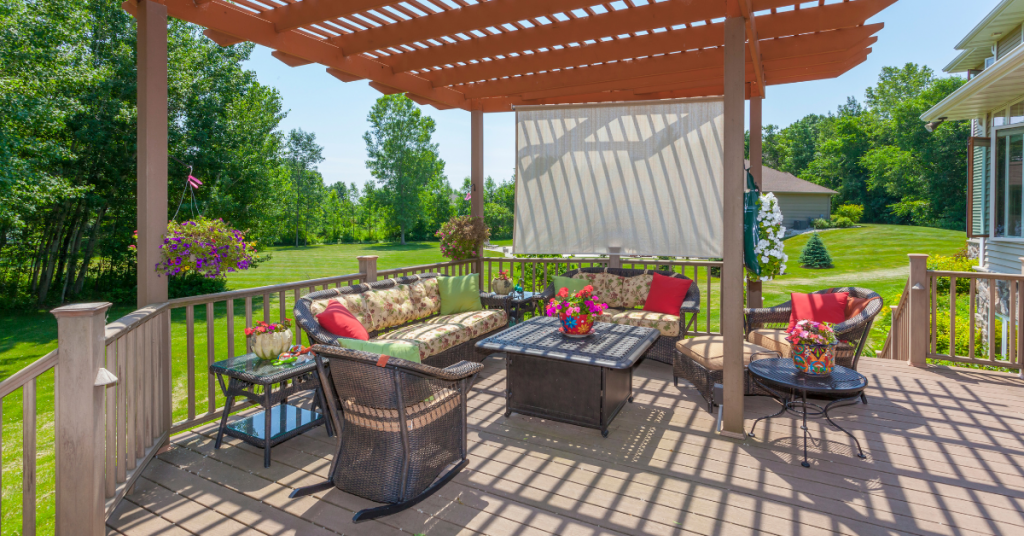Creating a pleasant outdoor area starts with choosing the right shade solution. Sunlight can make a patio too hot to enjoy and cause furniture to fade over time. A well-planned cover not only keeps the space cool but also extends the life of outdoor décor. Whether you want a flexible option you can adjust yourself or a solid structure that protects against rain, there is a choice for every home.

Adjustable Sun Control
If you need to change the amount of sun you let in, a system that rolls in and out is ideal. On very hot days, you can pull out the retractable awnings to cover your seating area. When the weather cools, you simply roll them up to let light stream in. These shades come in manual and motorised forms. A motorised version uses a switch or remote, so you do not have to reach up or struggle with a crank. The fabric picks and frame designs vary, so you can match the look of your home.
Precise Airflow and Light
Some homeowners value the ability to adjust slats for airflow and sun control. A louvre awning has horizontal blades that tilt to let in rays or keep them out. You can open the slats to catch a cool breeze without harsh glare or close them to block rain. This option blends well with modern and traditional homes alike. When fitted above windows or doors, these coverings give a neat, refined look and help lower indoor temperatures by preventing direct sunlight.
Solid Protection All Year
For long-term coverage over a deck or seating area, a fixed roof offers the strongest defense against sun and rain. High-quality patio covers use materials such as metal, treated wood, or thick polycarbonate panels. A clear panel option allows natural light to filter through while blocking harmful ultraviolet rays. With a solid roof in place, your outdoor furniture and rugs stay dry during sudden showers. This solution suits areas where you want to relax or entertain without worrying about weather changes.
Cost-Friendly Fabric Options
If you prefer a quick and simple shade that still looks neat, a fabric overhang can do the trick. Patio awnings attach to the wall of your home and extend over the area you wish to shade. These come in a range of fabrics, from canvas to PVC-coated cloth, and in various solid or striped patterns. Installation is straightforward and can often be completed in a few hours by a professional. When you no longer need shade, you roll the fabric back for a clean, tidy look.
Durable Metal Structures
For a sturdy, low-maintenance option, metal frames and panels can stand up to sun, wind, and rain for years. Aluminium awnings resist rust and will not warp or fade. These metal coverings attach securely to walls or frames and require only an occasional rinse to remove dirt or debris. They protect doors and windows as well, cutting glare inside the house and making rooms more comfortable. With a simple frame and solid panels, this option provides a neat, modern finish.
Planning and Placement
When planning your outdoor shade, think about how you use the space. If you like to dine outside, position your cover so it shades the table during lunch hours. For a lounge area, an adjustable option lets you chase the sun or shade as the light changes. Fixed covers work best over doorways and windows to reduce indoor heat gain. Measure the width you need and the projection to keep rain from blowing in. A slight tilt in a fixed cover helps water run off safely into side gutters.
Installation and Care
Proper installation ensures your investment lasts. Simple fabric awnings can be fitted in a few hours by someone experienced. More complex setups, such as motorised systems or metal covers, may take one or two days. Always hire a qualified installer who understands local building rules and can secure any necessary permits.
Maintenance varies by type. Fabric needs a gentle brush now and then to clear dust and prevent mold. Washing with mild soap and water in spring and autumn keeps it fresh. Metal and polycarbonate panels only need a quick rinse to remove bird droppings or dirt. Each year, check the mounting brackets to be sure they remain tight. For motorised shades, follow the maker’s guide to keep gears and electrical parts in good order.
Real-Life Example
A family in a suburban home wanted to host weekend barbecues without worrying about sudden showers. They chose a solid patio cover over their main seating area and added two manual retractable awnings on the sides. On sunny days, guests sat under the extended awnings for shade and enjoyed open views. When rain clouds rolled in, the solid roof kept the group dry. Children could move freely between shaded and open spots, and the parents did not have to pack up early. The set-up gave them a versatile area that worked in any weather.
Final Advice
Adding shade to your outdoor space makes it more usable and protects furniture from sun and rain. Whether you need a quick fix or a permanent structure, think about how you plan to use the area and pick the option that matches your lifestyle. Measure carefully, hire a skilled installer, and follow basic care tips to keep your shade in good shape. With the right choice, your patio or deck becomes a favourite spot for meals, gatherings, or simply relaxing with a book.